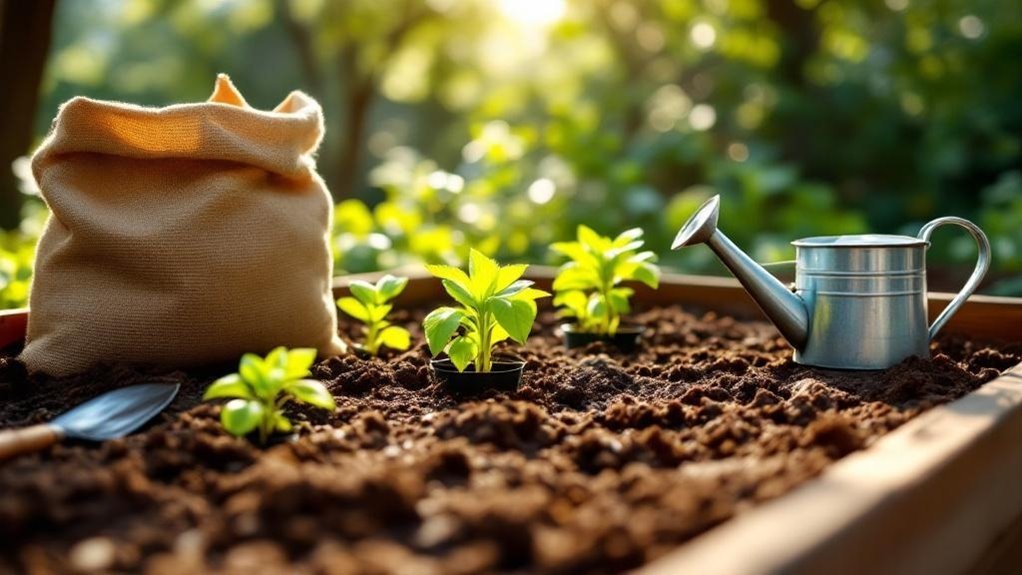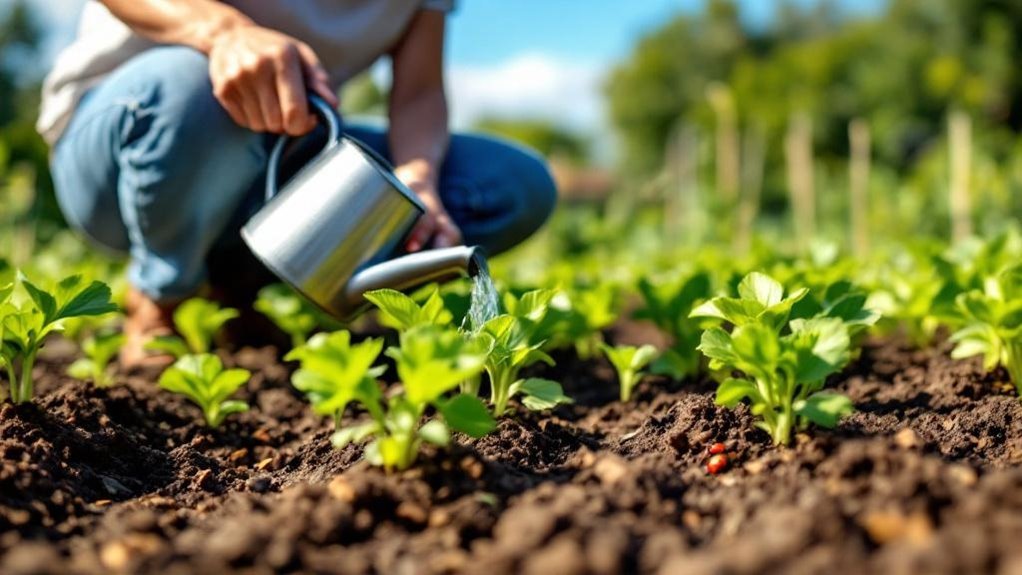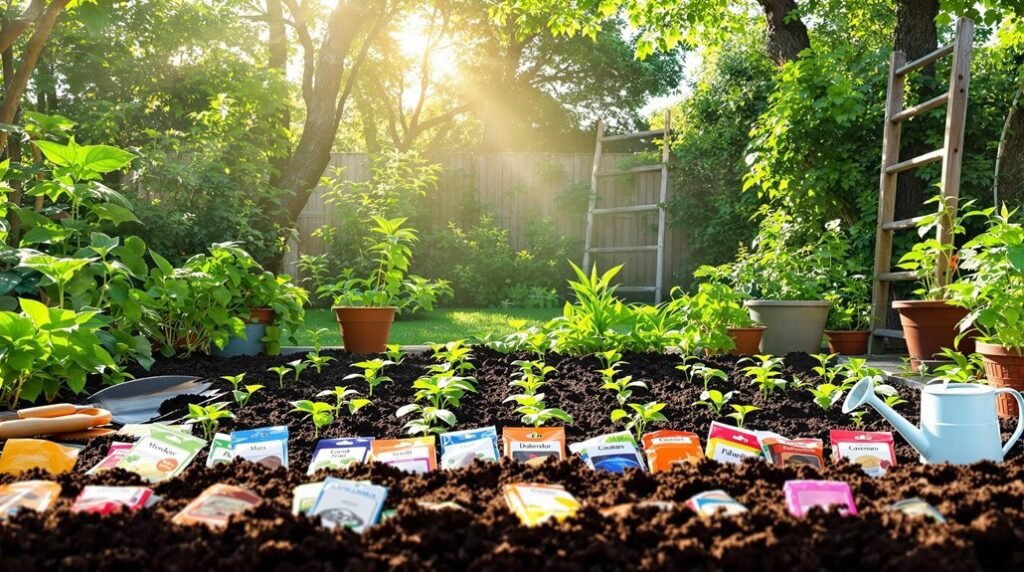If you’re thinking about growing your own vegetables, starting from scratch might seem overwhelming. You’ll need to find the right spot, prepare the soil properly, and choose plants that suit your space and skill level. But with a clear plan and some practical steps, you can set yourself up for success. Before you dig in, consider what makes a garden thrive and how to avoid common pitfalls.
Planning Your Vegetable Garden
Planning your vegetable garden starts with choosing the right location and size. Begin by drafting a garden plan that suits your available space and preferences.
Start your vegetable garden by selecting an ideal spot and designing a plan that fits your space and needs.
For beginners, raised beds measuring 4×4 or 4×8 feet work well, offering manageable areas with paths every 4 feet for easy access. Aim for a plot that gets 6 to 8 hours of sunlight daily and features well-draining soil rich in organic matter to boost plant health.
Early spring is the perfect time to prepare your soil and start planting. Select easy-to-grow vegetables like lettuce, green beans, and tomatoes, considering what your family enjoys and what’s available locally.
Using an online garden planning tool can help you visualize your layout, calculate spacing, and track important planting dates for a successful vegetable garden.
Selecting the Ideal Location and Plot Size
Choosing the right spot for your vegetable garden sets the foundation for healthy, productive plants. When selecting your garden’s location and plot size, focus on these fundamentals:
- Pick a location that gets 6 to 8 hours of direct sunlight daily—vegetables thrive with ample sunlight.
- Choose a manageable plot size, like a 10×10-foot area or raised beds measuring 4×4 or 4×8 feet, perfect for beginners.
- Confirm the soil is well-draining and nutrient-rich; using raised beds can improve both drainage and soil quality.
- Avoid windy spots that harm plants or pollinators and make certain you have easy access for watering, maintenance, and harvesting.
Preparing Raised Beds and Soil for Planting

Before you start planting, make certain your raised beds are properly prepared with nutrient-rich soil and good drainage.
Choose a sunny spot in your garden that gets at least six hours of direct sunlight and offers easy access for watering and maintenance.
Begin by lining the bottom of your raised bed with plain cardboard to suppress weeds and enrich the soil as it decomposes.
Use the no-dig method to fill the bed, layering well-rotted manure, compost, and straw.
Water each layer thoroughly to promote soil compaction and guarantee proper drainage.
Finally, top your bed with a generous layer of mulch like pea straw to retain moisture, suppress weeds, and improve soil health.
Proper preparation sets the stage for a thriving garden, especially when using open bottom designs that enhance drainage and promote healthy root development.
Choosing and Planting Your Vegetables
With your raised beds ready and soil enriched, you can start selecting vegetables that match your garden’s conditions and your experience level.
For a good start in spring, focus on easy-to-grow plants that thrive in your Raised Garden Bed. Here’s how to choose and plant:
- Pick beginner-friendly veggies like lettuce, tomatoes, and zucchini for reliable harvests.
- Use seedlings instead of seeds, especially for leafy greens like kale and spinach, easing management.
- Space plants properly based on their mature size to guarantee healthy growth and airflow.
- Plant seedlings using the no-dig method: dig small holes, place roots with compost, and set them at the right depth in your Garden Soil.
Additionally, consider testing your soil using a soil testing kit to ensure optimal nutrient levels for your plants.
Following these steps sets a strong foundation for your vegetable garden’s success.
Caring for Your Garden: Watering, Mulching, and Pest Control

Three key practices—watering, mulching, and pest control—will keep your vegetable garden healthy and productive.
Water your seedlings immediately after planting and maintain consistent watering, especially during dry spells, to help them establish strong roots and reduce transplant shock.
After planting, apply a generous layer of pea straw mulch to retain soil moisture and suppress weeds, which supports overall garden health.
For pest control, keep an eye out for common pests like white cabbage butterflies and their eggs. Early detection is essential, so check plants regularly for any signs of damage.
Consider building a DIY net structure to protect your garden without harsh chemicals. Incorporating user-friendly designs in your gardening setup can enhance your overall gardening experience.
These steps guarantee your garden thrives with minimal stress and maximum yield.
Frequently Asked Questions
How to Make a Garden Step by Step for Beginners?
You’ll start by picking a sunny spot with good soil, then plan your garden size. Prepare beds with compost, choose easy veggies, plant seedlings properly, and maintain by watering, mulching, and watching for pests regularly.
What Is the Most Common Mistake of First Time Gardeners?
Planting too many seeds at once is like crowding a party—your plants compete for nutrients, light, and water. You’ll want to space them out wisely to give each one room to thrive and grow strong.
What Vegetables Should Not Be Planted Next to Each Other in a Garden?
You shouldn’t plant tomatoes next to potatoes, carrots near dill, or beans beside onions and garlic. Keep cucumbers away from potatoes, and avoid placing brassicas close to strawberries to prevent disease and growth issues.
What Is the Easiest Vegetable Garden for Beginners?
You’ll want to create a friendly garden playground with quick-growing veggies like lettuce and radishes. Using raised beds and seedlings keeps things simple, while a cozy 10×10 spot helps you master gardening without feeling overwhelmed.
Final Thoughts
Starting your vegetable garden from scratch is simpler than you might think. With just 6 to 8 hours of sunlight and proper soil preparation using the no-dig method, you’ll set your plants up for success. Fun fact: home gardeners produce about 15% of the world’s vegetables, showing how powerful your small garden can be. By carefully planning, planting, and caring for your veggies, you’ll enjoy fresh, healthy produce right from your own backyard.
